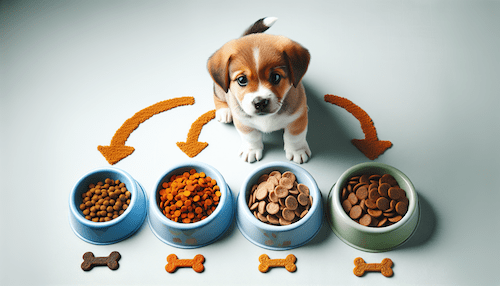Puppy nutrition is essential to ensure the healthy growth and development of your little dog. As a new pet owner, you may have questions among the myriad of food options available, and understanding your puppy’s specific nutritional needs will help you make informed choices.
In this article, we will explore the key details of puppy feeding so you can learn about the importance of a balanced diet, rich in proteins, fats, and carbohydrates. We will also discuss how nutritional needs vary according to your pet’s breed and size.
By the end of this guide, you will be prepared to make the best choices for your furry friend’s well-being. Keep reading to discover everything you need to know about the essential feeding of puppies!
Important Points in Puppy Nutrition
Proper puppy nutrition for puppies encompasses a balance of proteins, fats, carbohydrates, vitamins, minerals, and water, with different requirements for large and small breeds to support their respective growth rates and energy levels.
When selecting puppy food, it is critical to choose a complete and balanced option certified by the AAFCO, and consider the type of food (dry, wet, or raw) that best suits the puppy’s preferences and nutritional needs.
A structured feeding schedule and portion sizes tailored to the puppy’s age, breed size, and growth progress are essential for preventing nutritional deficiencies and obesity, with regular monitoring and adjustment of their diet as they mature into adulthood.
Understanding Puppy Nutrition: The Basics

A puppy’s nutrition plays a key role in their development. It provides essential components like water, fats, proteins, vitamins, minerals, and carbohydrates necessary for their growth. Furthermore, a puppy’s breed size can significantly influence its nutritional requirements.
While giant breed puppies have an extended growth phase that necessitates specialized puppy nutrition, smaller breeds generally reach maturity more quickly and require a diet customized to their faster metabolism.
Maintaining a balanced caloric intake for your puppy is vital. The amount of calories your puppy needs can be influenced by their breed size, activity level, and age.
Overfeeding can lead to obesity and other health issues, while underfeeding can hinder their growth and development. Hence, selecting puppy food certified by the Association of American Feed Control Officials (AAFCO) is highly recommended.
This certification ensures that the puppy food adheres to the nutritional standards necessary for optimal health.
Essential Nutrients for Puppies
Newborn puppies primarily get their nutrition from their mother’s milk. This milk is rich in essential nutrients required for their growth and development, such as:
- protein
- fats
- carbohydrates
- vitamins
- minerals
- water
Hence, feeding your growing puppy a complete and balanced diet is of utmost importance for their healthy growth. Any deficiency in essential nutrients can compromise both their short- and long-term health.
When it comes to puppy foods, solid food options for puppies benefit from a diet rich in:
- vegetables
- fruit
- whole grains
- legumes
These foods provide readily available energy, ensuring that puppies have the vitality to engage in activities and support their growth throughout the day. But it’s not just about the food type, but the quality of the food that matters too.
High-quality, human-grade muscle, and organ meats are excellent sources of protein, promoting healthy physical development vital for their transition to adult dogs.
Large Breed vs. Small Breed Nutritional Needs
The breed size of your puppy plays a significant role in determining their nutritional needs. Large breed puppies, for instance, have distinct dietary requirements to support their rapid growth and minimize potential orthopedic problems.
On the other hand, small breed puppies require food tailored to their elevated energy levels and faster metabolisms.
For instance, large breed puppies require a dietary calcium range of 0.8% to 1.2% on a dry matter basis and a protein range of 22-32% on a dry matter basis for their rapid growth. Monitoring their calcium intake is crucial.
An excessive amount of calcium can lead to skeletal abnormalities, thereby impacting their overall well-being. Inadequate puppy nutrition in large breed puppies may lead to orthopedic issues, such as developmental orthopedic disease, hip and elbow dysplasia, and osteochondrosis/osteochondritis dissecans.
Choosing the Right Puppy Food

Selecting the appropriate food for puppy nutrition is a fundamental step in guaranteeing their health and well-being.
When selecting puppy food, you must ensure that the labels indicate a complete and balanced diet, with high-quality ingredients and appropriate nutrient levels.
But it’s not just about the ingredients. The type of food also matters. Puppies can eat dry, wet, or raw food, and the choice often depends on the puppy’s preferences, dietary requirements, and the owner’s lifestyle.
Sometimes, puppies may not respond positively to a specific type of food. If this happens, it’s advisable to adopt a trial and error approach while ensuring that the food is specifically formulated for puppies.
It may take several attempts to find the right food, but remember, it’s crucial to gradually transition your puppy to new food to prevent digestive issues.
Evaluating Puppy Food Labels
When evaluating puppy food labels, one of the main things to look out for is the American Association for Feed Control Officials (AAFCO) nutritional adequacy statement.
This statement on the pet food label is an indication that the food offers complete and balanced puppy nutrition for growth. AAFCO is a voluntary organization responsible for setting nutritional and labeling standards for animal food products in the United States.
The guidelines established by AAFCO are key to ensuring that the chosen food fulfills the essential nutritional needs of puppies.
The essential nutrients that should be included on a puppy food label are protein, fat, fiber, water, calcium, phosphorus, sodium, and linoleic acid.
To identify high-quality puppy food, look for whole proteins and quality carbohydrates at the top of the ingredient list. Additionally, the food should contain minimal fillers and have salt or potassium chloride listed as minor ingredients.
Dry, Wet, or Raw?
In deciding whether to feed your puppy dry, wet, or raw food, considering the nutritional differences among them is paramount. Here are the key differences:
- Dry food: It has lower moisture content and higher carbohydrates. It offers balanced puppy nutrition and is convenient for storage and feeding.
- Wet food: It contains more meat protein and fewer carbohydrates. It has higher moisture content and can be more palatable for picky eaters.
- Raw food: It is recognized for its abundance of easily digestible nutrients, natural vitamins, minerals, and amino acids. It is the closest to a dog’s natural diet.
Consider your puppy’s specific needs and consult with your vet to determine the best food option for them.
Each type of food has its benefits and drawbacks. Dry dog food, for instance, is:
- Easy to administer
- Has an extended shelf life
- Is cost-effective
- Can support weight management and dental health
However, it may not be as appealing to puppies as other types of food, and there is a possibility of contamination with bacteria and mycotoxins.
When it comes to a puppy’s dental health, dry food can aid in minimizing plaque and tartar accumulation, promoting dental hygiene. Nevertheless, wet and raw food can also contribute to a dental care regimen if combined with suitable dental hygiene practices.
Feeding Your Puppy: Schedules and Portions

The feeding schedules and portion sizes must be suitable for your puppy’s age and should be modified according to their growth and activity level. Proper puppy nutrition is crucial for ensuring your puppy develops healthily.
The recommended daily amount of food for a puppy should be determined based on the puppy’s breed, age, and size. Modifying schedules and portion sizes in line with your puppy’s growth and activity level can help maintain their energy level and reduce the likelihood of gastric issues such as bloat.
Take into account that a young dog’s dietary requirements can be swayed by factors such as their activity level, age, and breed.
These factors play a role in determining the appropriate amount of food they should consume. Feeding schedules are also critical. Here are some guidelines to follow:
- Puppies should be fed three to four times a day during their growth stage to meet their puppy nutrition needs;
- As they reach one year old, feeding them twice a day is appropriate;
- The quantity of food should be sufficient to promote their musculoskeletal development and should be gradually increased until they reach 80% of their mature size.
Age-Appropriate Feeding Schedules
Feeding schedules can vary significantly depending on your puppy’s age. For instance, a 2-month-old puppy should typically be fed 3 to 4 times daily, with meals distributed across the morning, mid-morning, early-afternoon, and evening.
As your puppy grows older, you can reduce the number of meals. Puppies can transition from three meals a day to two at approximately six months of age, reflecting their reduced need for the more frequent feedings required when they were younger.
The feeding schedules can also vary based on the breed size. Typically, large breed puppies should initially be fed four times a day with unmoistened dry food, transitioning to three times a day at 8 weeks old, and eventually to twice a day as they continue to grow.
On the other hand, small breed puppies require more frequent feeding, typically four to six meals a day until approximately four months old, after which the frequency can be reduced to two or three meals a day.
Portion Sizes and Adjustments
Determining the correct portion size for your puppy is essential for effective puppy nutrition. The appropriate portion size for puppy food is determined by the weight of the puppy, typically falling within the range of 0.5-1.25 cups.
You can use a dog food calculator or employ a measuring cup or kitchen scale to accurately measure the portion size for optimal feeding.
It’s also important to adjust your puppy’s portion sizes based on their body condition and growth rate. If your puppy retains excess weight for an extended period, it may indicate the necessity to adjust their portion size. You should adjust your puppy’s portion size if they are still maintaining a round shape after 12 weeks.
Additionally, during the three to six months stage, it is advisable to decrease the number of feedings from four to three times a day. If you’re transitioning your puppy to a new type of food, do it gradually over a 7- to 10-day timeframe to prevent any digestive issues.
Monitoring Your Puppy’s Weight and Body Condition

Keeping a close eye on your puppy’s weight and body condition is a crucial part of ensuring they are growing at a healthy rate and receiving proper puppy nutrition.
The ideal body condition for a puppy is characterized by their easily to tough ribs with thin layer of fat covering, a noticeable waist when viewed closely, and an obvious abdominal tuck when observed from their side. The body condition scoring guide serves as a valuable tool to assess and maintain your puppy’s healthy weight.
To ensure an optimal body condition, it’s advisable to regularly monitor your puppy’s weight and body condition score, and make adjustments to their food intake as needed. If you observe any signs of excessive weight gain or loss in your puppy, consult with a veterinarian immediately.
It’s also important to note that by around six months old, your puppy’s body condition should start to mirror that of an adult dog.
Assessing Your Puppy’s Body Condition
To assess your puppy’s body condition, observe your puppy from above and from the side, and then palpate the ribs and spine. You should be able to feel the ribs with a thin layer of fat covering them. If the ribs are visible or feel bony, the puppy may be underweight.
Conversely, if you can’t feel the ribs due to a thick layer of fat, your puppy may be overweight, indicating a need for adjustments in their puppy nutrition.
Also, take a look at your puppy’s waistline and abdominal tuck. A healthy puppy’s waist should be visible when observed from above, indicating a waistline. Additionally, the abdominal region should exhibit an upward tuck when observed from the side. These are indicative of a healthy body condition in puppies.
Addressing Weight Concerns
If you’re concerned about your puppy’s weight, don’t worry, there’s plenty you can do. Regularly weigh your puppy and adjust their portions according to the instructions on your dog’s food to ensure they receive adequate puppy nutrition.
This is particularly crucial for smaller breed dogs, as their growth spurts are more rapid than those of larger dogs, and may require more frequent adjustments. Additionally, providing your puppy with toys to encourage active behavior can be beneficial.
If you observe a ten percent weight loss or when your puppy reaches six months of age, it is advisable to consult a veterinarian for a comprehensive health assessment.
If your puppy is overweight, consider implementing a weight loss diet that is rich in protein and low in carbohydrates. For an underweight puppy, provide one high-calorie meal and include nutrient-dense foods to promote weight gain. Remember, any significant weight concerns should always be addressed with a vet.
Transitioning to Adult Dog Food

As your puppy grows and matures, there will come a time when you’ll need to transition them from puppy food to adult dog food. The transition to adult dog food is typically advised between 9 and 12 months of age for most puppies, depending on their puppy nutrition requirements.
However, the appropriate age for this transition can vary based on the specific breed and size of the dog. Here are some general guidelines:
- Small-breed dogs may make the transition as early as 7 to 9 months.
- Medium-sized dogs are generally ready to switch between 12 and 15 months.
- Large-breed dogs may need to stay on puppy food for a longer period of time, typically until they are 18 to 24 months old.
It’s important to consult with your veterinarian to determine the best time to transition your puppy to adult dog food based on their individual puppy nutrition needs.
As you transition your puppy to adult food, monitoring their body condition is vital to ensure their health and smooth adjustment to the new diet throughout the transition period.
Determining the Right Time to Switch
Determining the right time to switch your puppy to adult food depends on various factors. These include:
- The puppy reaching about 80% of their adult size
- The breed and size of the dog
- Whether they are spayed or neutered
- Their activity level
Larger and giant breeds have a longer maturation period, necessitating a longer duration of consuming puppy food compared to small- or medium-sized breeds.
In essence, your puppy’s transition to adulthood is more strongly tied to their breed size than their chronological age, affecting their puppy nutrition.
For instance, large- and giant-breed dogs weighing over 50 pounds at full maturity may not be ready to switch to adult food until they reach 12 to 24 months of age.
Gradual Transition Process
When it’s time to switch your puppy to adult food, it’s best to do it gradually over a 7- to 10-day timeframe to support their puppy nutrition.
Start by mixing adult food with puppy food at a ratio of 1:4, or 20% adult food and 80% puppy food. This ratio should be gradually adjusted over a minimum of one week to increase the proportion of adult food and decrease the proportion of puppy food.
Keeping a close watch on your puppy’s reaction to the new food throughout the transition process is essential.
A puppy can be considered to be adapting well to the new adult food if there are no signs of gastrointestinal upset such as vomiting or diarrhea, and if they maintain a healthy appetite throughout the transition process.
If the transition is sudden rather than gradual, it may lead to potential digestive issues.
Supplementing Your Puppy’s Diet
In some instances, your puppy’s diet may require supplementation to ensure optimal puppy nutrition. This is particularly true when they reach specific age milestones, such as 1 year old for smaller breeds and 8 weeks of age for large breed dogs, in order to provide essential nutrients for their growth phase.
Supplements can contribute to the optimal growth of puppies by providing essential nutrients such as B vitamins that are necessary for their development. Additionally, including digestive enzymes and probiotics can enhance nutrient availability and absorption.
Keep in mind that certain health issues may require diet supplementation in puppies. For instance, calcium deficiency is a notable health concern in puppies that may necessitate diet supplementation to prevent conditions such as osteomalacia and to ensure proper metabolic bone development.
Common Supplements for Puppies
There are several supplements that can benefit your puppy’s growth and development. These include:
- Vitamins
- Minerals
- Glucosamine
- Chondroitin
- Methylsulfonylmethane (MSM)
These supplements are essential for supporting their hip and joint health. Joint support supplements for puppies provide assistance in maintaining joint health, minimizing inflammation, promoting cartilage regeneration, and stimulating joint cartilage.
While joint support supplements can be beneficial, it’s important not to start them too early. It is advisable to commence joint supplements at 1 year old, although puppies can generally start taking supplements as early as 10 months old.
Consulting with Your Veterinarian
Before introducing any supplements into a puppy nutrition, consulting with your vet is a must. If your puppy shows signs of excessive weight loss, lethargy, joint weakness, behavior changes, diarrhea, vomiting, and constipation, these might indicate a need for dietary supplements.
Consult your vet about the appropriateness of supplements for your puppy. They can assess the necessity for supplementation and provide guidance on suitable amounts and sources.
Your vet may conduct blood and biochemistry tests to gain a more comprehensive understanding of your puppy’s health condition and nutritional requirements. Remember, the goal is to ensure your puppy is receiving a balanced diet that supports their growth and development.
Conclusion: The Importance of Puppy Nutrition
In conclusion, providing your puppy with the right nutrition is a multifaceted task that involves understanding their nutritional needs, choosing the right food, setting the right feeding schedule, monitoring their weight and body condition, and knowing when and how to transition them to adult food.
In some cases, supplementing their diet may be necessary to ensure comprehensive puppy nutrition. Remember, every puppy is unique, and their nutritional needs can vary based on their breed, size, age, and activity level. With the right nutrition, you’re setting your puppy up for a lifetime of health and happiness.
Frequently Asked Questions
Puppies need a diet rich in protein, fat, calcium, and digestible carbohydrates to support their growth and development. Protein requirements are highest after weaning but decrease gradually as they grow.
To ensure proper growth and development, it’s best to feed your puppy a high quality commercial kibble designed for puppies, with the option to add cooked meats and vegetables. Around the age of one, you may transition them to adult food or as advised by your vet.
To ensure proper growth and development, it’s best to feed your puppy a high quality commercial kibble designed for puppies, with the option to add cooked meats and vegetables. Around the age of one, you may transition them to adult food or as advised by your vet.
Yes, puppies can eat wet food, especially for very young puppies past the weaning stage. It can be a convenient option for both the puppy and the owner.
To evaluate if a puppy food offers complete and balanced nutrition, look for the AAFCO nutritional adequacy statement on the pet food label, indicating that the food is suitable for growth.
You should transition your puppy to adult dog food between 9 and 12 months of age, taking into account the breed and size of your dog. Timing may vary based on these factors.

